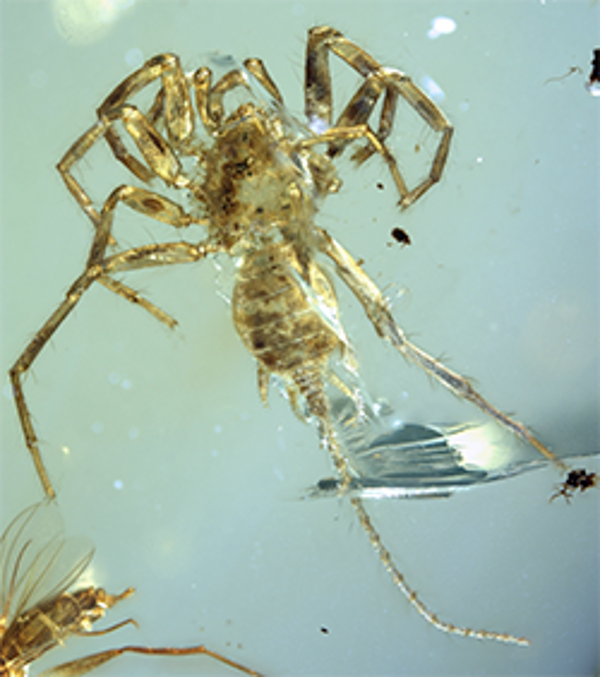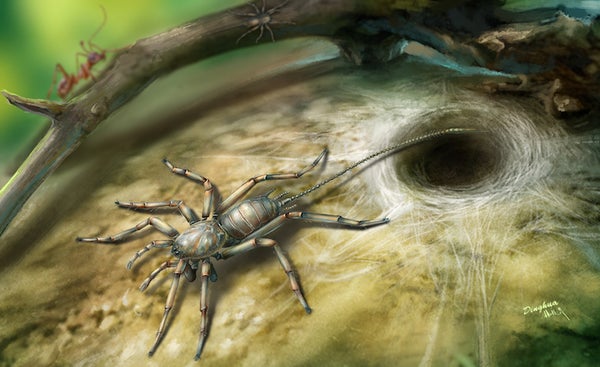This article was published in Scientific American’s former blog network and reflects the views of the author, not necessarily those of Scientific American
Dinosaurs overshadow everything. Looking at depictions of Mesozoic ecosystems, sometimes it's easy to believe that the food web in the heyday of the terrible lizards only included carnivorous dinosaurs, herbivorous dinosaurs, and plants. But it's worth zooming in a little - looking past the famous saurians - at the other, less-famous organisms of the time. Consider, for example, protospiders.
About 100 million years ago, in what's now Myanmar, four little arachnids independently became trapped in amber. These are the invertebrates now described as Chimerarachne yingi by paleontologist Bo Wang and colleagues, and they present mix-and-match features that place them close to the origin of the various eight-legged friends who've taken up residence in our homes and gardens.
At first glance, Chimerarachne doesn't look very much like house spiders you're familiar with. For one thing, it has a tail-like appendage called a flagellum. (This wasn't a weapon, but a sensory organ.) With an arachnologist's eye, however, you might spot features like fangs and silk-producing spinnerets that make Chimerarachne a closer relative of modern fossils than similar, previously-discovered fossils. They're not spiders, proper, but they're the next closest thing.
On supporting science journalism
If you're enjoying this article, consider supporting our award-winning journalism by subscribing. By purchasing a subscription you are helping to ensure the future of impactful stories about the discoveries and ideas shaping our world today.
But this doesn't mean that true spiders evolved after Chimerarachne. The oldest representatives of true spiders are far older, dating back to about 300 million years ago. This means that Chimerarachne is a late-surviving member of the group from which true spiders likely emerged, so more-or-less "modern" spiders co-existed with members of their ancestral lineage for millions upon millions of years. The tale of Chimerarachne thus becomes a success story, just one of many ways of arachnid evolutionary expression persisting through time.

A photo of Chimerarachne. Credit: University of Kansas & KU News Service
Name: Chimerarachne yingi
Meaning: Chimerarachne means "chimera spider" - in reference to the arachnid's mix of traits - while yingi honors the fossil's collector, Yanling Ying.
Age: Cretaceous, about 100 million years ago.
Where in the world?: Northern Myanmar.
What sort of organism?: An arachnid belonging to a group called the Uraraneida.
How much of the organism’s is known?: Four specimens in amber.
References:
Wang, B., Dunlop, J., Selden, P., Garwood, R., Shear, W., Müller, P., Lei, X. 2018. Cretaceous arachnid Chimerarachne yingi gen. et. sp. nov. illuminates spider origins. Nature Ecology & Evolution. doi: 10.1038/s41559-017-0449-3
Huang, D., Hormiga, G., Cai, C., Su. Y., Yin, Z., Xia. F., Giribet, G. 2018. Origin of spiders and their spinning organs illuminated by mid-Cretaceous amber fossils. Nature Ecology & Evolution. doi: 10.1038/s41559-018-0475-9
More Paleo Profiles:
The Light-Footed Lizard The Maoming Cat Knight’s Egyptian Bat The La Luna Snake The Rio do Rasto Tooth Bob Weir's Otter Egypt's Canine Beast The Vastan Mine Tapir Pangu's Wing The Dawn Megamouth The Genga Lizard The Micro Lion The Mystery Titanosaur The Echo Hunter The Lo Hueco Titan The Three-Branched Cicada The Monster of Minden The Pig-Footed Bandicoot Hayden's Rattlesnake Demon The Evasive Ostrich Seer The Paradoxical Mega Shark The Tiny Beardogs The Armored Fish King North America's Pangolin The Invisible-Tusked Elephant The Mud Dragon The Spike-Toothed Salmon The Dream Coast Crocodile Buriol's Robber Ozimek's Flyer The Northern Naustoceratopsian The High Arctic Flyer The Tomatillo From the End of the World The Short-Faced Hyena The Mighty Traveler from Egg Mountain Keilhau's Ichthyosaur Mexico's Ancient Horned Face Mauricio Fernández's Plesiosaur New Zealand's Giant Dawn Penguin The Orange Sea Lion Mongolia's Ginkgo Cousin The Geni River Frog Isabel Berry's Dinosaur The Whale Caiman The Moab Lizard Yang Zhongjian's Lizard The Little Anubis The Shuangbai Lizard The Wyvern Dinosaur The "Need Helmet" Dinosaur The Jianianhua Dragon The Liaoning Hunter The Dalian Lizard Crompton's Aleodon Jenkins' Amphibian Serpent From the Chinle The Large Ancestor Lizard The Crown Tooth Currie's Alberta Hunter The Elephant Bird Mimic The Crested Thief The Hiding Hunter The Horned Lizard The Silk Bird The Sieve-Toothed Plesiosaur The Defenseless Snout Burian's Lizard The Small Whaitsiid The Beautiful Bird The Fierce Cat The Older One From Melksham The King of the Miocene Iberian Giraffes Miera's Lizard The Traveling Sloth The Sand Whale Shouten's Marsupial Lion The Rhaetian Lizard The Mountain Dolphin The Bryant's Shark The Rainbow Dinosaur Kootenay Bristle Worm The Masaoura Lizard
